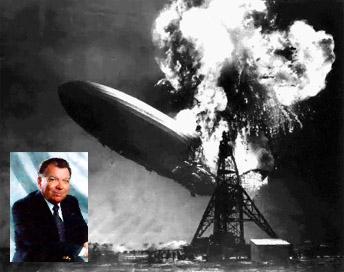 Addison Bain (inset) and the Hindenburg's final moments. Image from http://www.geocities.com/Area51/Zone/5942/hindenburg_index.html; inset image from http://www.fsec.ucf.edu/bain.htm |
Bain's hunt for the truth about the Hindenburg began in the late 1960s, when he was working on hydrogen systems. The Hindenburg was frequently used as an example in hydrogen safety manuals, but the reported observations of the incident were inconsistent. For example, Bain noticed that the fire burned rapidly in many directions, the zeppelin remained aloft and upright for many seconds after the initial flames were seen, and the flames were bright - none of which are consistent with a hydrogen explosion. He spent large chunks of time researching original documentation of the disaster, which was enough to convince him that the airship's materials had contributed to the ignition of the blaze, but he lacked solid evidence to prove his theory.
Finally, in 1994 Bain obtained samples of the fabric that had covered the Hindenburg and had a volunteer team of scientists analyze them using a variety of physical and chemical techniques, including an infrared spectrograph and a scanning electron microscope, which provided the chemical signatures of the organic compounds and elements present. His conclusion: the source of the fire was the use of lacquers and metal-based paints on the outer hull and bladders, which were ignited by an electrical discharge. "I guess the moral of the story is, don't paint your airship with rocket fuel," Bain said at the time of announcing his discovery.
Ironically, Bain's findings are not well-known, and hence most scientists and members of the public persist in the uncritical belief that hydrogen caused the Hindenburg blaze. Both Heben and Sage believe that this prejudice undermines recent interest in using hydrogen as a fuel and energy storage medium. As Heben wrote, "The distribution of unsubstantiated and incorrect lore regarding this incident greatly harms the world-wide efforts to develop hydrogen technologies for the replacement of fossil fuel."
We stand corrected.
©1995 - 2024, AMERICAN PHYSICAL SOCIETY
APS encourages the redistribution of the materials included in this newspaper provided that attribution to the source is noted and the materials are not truncated or changed.
Associate Editor: Jennifer Ouellette
July 2000 (Volume 9, Number 7)
Articles in this Issue

